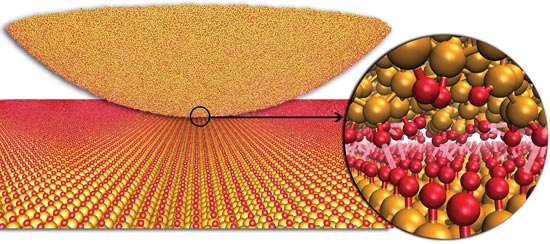Home > Press > Models present new view of nanoscale friction
 |
| This graphic recreates an atom-level view of the nanoscale interface between carbon and diamond. At such a small scale, the surfaces are rough, although researchers have been treating them as smooth.
Image: Izabela Szlufarska |
Abstract:
To understand friction on a very small scale, a team of UW-Madison engineers had to think big.
Friction is a force that affects any application where moving parts come into contact; the more surface contact there is, the stronger the force. At the nanoscale — mere billionths of a meter — friction can wreak havoc on tiny devices made from only a small number of atoms or molecules. With their high surface-to-volume ratio, nanomaterials are especially susceptible to the forces of friction.
Models present new view of nanoscale friction
Madison, WI | Posted on February 25th, 2009But researchers have trouble describing friction at such small scales because existing theories are not consistent with how nanomaterials actually behave. Through computer simulations, the group demonstrated that friction at the atomic level behaves similarly to friction generated between large objects. Five hundred years after Leonardo da Vinci discovered the basic friction laws for large objects, the UW-Madison team has shown that similar laws apply at the nanoscale.
The team, which was led by Izabela Szlufarska, an assistant professor of materials science and engineering, and included materials science and engineering graduate student Yifei Mo and mechanical engineering assistant professor Kevin Turner, published its findings in the Feb. 26 issue of the journal Nature.
Current nanoscale friction theories are based on the idea that nanoscale surfaces are smooth, but, in reality, the surfaces resemble a mountain range, where each peak corresponds to an atom or a molecule.
The UW-Madison team performed computer simulations that looked at nanoscale materials as a collection of atoms, monitoring their positions and interactions throughout the entire sliding process. "For the first time, we modeled friction at length scales very similar to experiments, while maintaining atomic resolution and realistic interactions between atoms," say Szlufarska.
The team discovered simple laws of nanoscale friction. They found that friction is proportional to the number of atoms that interact between two nanoscale surfaces. The researchers' simulations showed that, at the nanoscale, materials in contact behave more like large rough objects rubbing against each other, rather than as two perfectly smooth surfaces, as was previously imagined. "When you look at it closely, the surface is made of atoms, so the contact is actually rough," says Szlufarska.
The team's simulation data correlates very well with recorded experimental data — something that previous models have failed to accomplish. Szlufarska hopes to use the simulations as a tool to understand what mechanisms contribute to friction on both the nano- and macroscale.
"Nobody is able to predict friction or design materials with desired friction properties — we measure a lot of friction coefficients for different materials, but it's not really clear how to relate them to the properties of the material," she explains. "The origin of friction is really an open and growing research field."
The National Science Foundation and by the American Chemical Society Petroleum Research Fund supported the team's research.
####
For more information, please click here
Contacts:
Liz Ahlberg
Copyright © UW-Madison
If you have a comment, please Contact us.Issuers of news releases, not 7th Wave, Inc. or Nanotechnology Now, are solely responsible for the accuracy of the content.
| Related News Press |
News and information
![]() Researchers develop molecular qubits that communicate at telecom frequencies October 3rd, 2025
Researchers develop molecular qubits that communicate at telecom frequencies October 3rd, 2025
![]() Next-generation quantum communication October 3rd, 2025
Next-generation quantum communication October 3rd, 2025
![]() "Nanoreactor" cage uses visible light for catalytic and ultra-selective cross-cycloadditions October 3rd, 2025
"Nanoreactor" cage uses visible light for catalytic and ultra-selective cross-cycloadditions October 3rd, 2025
Discoveries
![]() Researchers develop molecular qubits that communicate at telecom frequencies October 3rd, 2025
Researchers develop molecular qubits that communicate at telecom frequencies October 3rd, 2025
![]() Next-generation quantum communication October 3rd, 2025
Next-generation quantum communication October 3rd, 2025
![]() "Nanoreactor" cage uses visible light for catalytic and ultra-selective cross-cycloadditions October 3rd, 2025
"Nanoreactor" cage uses visible light for catalytic and ultra-selective cross-cycloadditions October 3rd, 2025
Materials/Metamaterials/Magnetoresistance
![]() First real-time observation of two-dimensional melting process: Researchers at Mainz University unveil new insights into magnetic vortex structures August 8th, 2025
First real-time observation of two-dimensional melting process: Researchers at Mainz University unveil new insights into magnetic vortex structures August 8th, 2025
![]() Researchers unveil a groundbreaking clay-based solution to capture carbon dioxide and combat climate change June 6th, 2025
Researchers unveil a groundbreaking clay-based solution to capture carbon dioxide and combat climate change June 6th, 2025
![]() A 1960s idea inspires NBI researchers to study hitherto inaccessible quantum states June 6th, 2025
A 1960s idea inspires NBI researchers to study hitherto inaccessible quantum states June 6th, 2025
![]() Institute for Nanoscience hosts annual proposal planning meeting May 16th, 2025
Institute for Nanoscience hosts annual proposal planning meeting May 16th, 2025
Announcements
![]() Rice membrane extracts lithium from brines with greater speed, less waste October 3rd, 2025
Rice membrane extracts lithium from brines with greater speed, less waste October 3rd, 2025
![]() Researchers develop molecular qubits that communicate at telecom frequencies October 3rd, 2025
Researchers develop molecular qubits that communicate at telecom frequencies October 3rd, 2025
![]() Next-generation quantum communication October 3rd, 2025
Next-generation quantum communication October 3rd, 2025
![]() "Nanoreactor" cage uses visible light for catalytic and ultra-selective cross-cycloadditions October 3rd, 2025
"Nanoreactor" cage uses visible light for catalytic and ultra-selective cross-cycloadditions October 3rd, 2025
|
|
||
|
|
||
| The latest news from around the world, FREE | ||
|
|
||
|
|
||
| Premium Products | ||
|
|
||
|
Only the news you want to read!
Learn More |
||
|
|
||
|
Full-service, expert consulting
Learn More |
||
|
|
||








